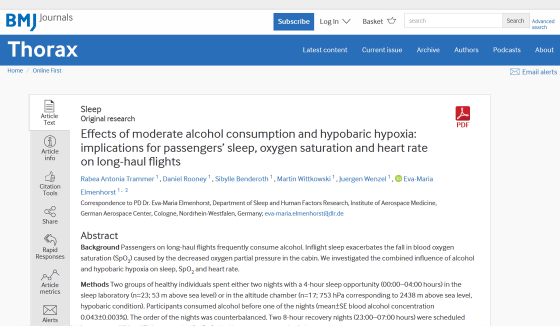Why is it dangerous to drink alcohol on an airplane?

When you're on a plane, you may have had the experience of ordering a beer or an alcoholic cocktail. However, a new study has shown that drinking alcohol on an airplane can put extra strain on your heart and be dangerous.
Effects of moderate alcohol consumption and hypobaric hypoxia: implications for passengers' sleep, oxygen saturation and heart rate on long-haul flights | Thorax

Drinking Alcohol on Planes May Pose a Hidden Danger. Here's Why. : ScienceAlert
https://www.sciencealert.com/drinking-alcohol-on-planes-may-pose-a-hidden-danger-heres-why
At low atmospheric pressure, such as at high altitudes or inside an aircraft, the pressure of oxygen in the air also decreases, causing a decrease in the human blood oxygen saturation (SpO₂). This is known as hypobaric hypoxia, and a research team from the Institute of Aerospace Medicine at the German Aerospace Center investigated the effects of alcohol intake and sleep on hypobaric hypoxia.
In the study, 40 subjects were assigned to sleep in a room with the same air pressure as on the ground (equivalent to 53 meters above sea level) or in a room with the same air pressure as inside a cruising aircraft (equivalent to 2,438 meters above sea level). They slept for a total of two nights, with or without consuming alcohol the night before.
The subjects consumed the equivalent of two cans of beer or two glasses of wine and were given four hours of sleep. Four hours of sleep may seem quite short, but this was due to the fact that it was difficult to fall asleep during the flight and sleep disturbances could occur.

The results showed that at normal atmospheric pressure, people who consumed alcohol had an average blood oxygen saturation of 94.97% and an average heart rate of 76.97 beats per minute, while people who did not consume alcohol had an average blood oxygen saturation of 95.88% and an average heart rate of 63.74 beats per minute.
At the same pressure as inside a cruising aircraft, people who consumed alcohol had an average blood oxygen saturation of 85.32% and an average heart rate of 87.83 beats per minute, while people who did not consume alcohol had an average blood oxygen saturation of 88.07% and an average heart rate of 72.9 beats per minute.
Taken together, these results suggest that the air pressure inside an aircraft causes lower blood oxygen saturation and higher heart rate than on the ground, and that the effects are exacerbated by the intake of alcohol. As a healthy blood oxygen saturation level is above 90%, consuming alcohol on an aircraft may have adverse effects on health.
Low blood oxygen saturation and high heart rate put additional strain on the cardiovascular system, so for frequent long-haul flyers or those with underlying medical conditions, drinking alcohol on an airplane could unnecessarily increase the risk of heart disease.

'This study was conducted with a small number of participants, all of whom were young and healthy, so the impact may be greater in older people or those with underlying medical conditions. We show that in-flight alcohol consumption is an underestimated health risk factor that is easily avoided,' the researchers said.
Related Posts:







